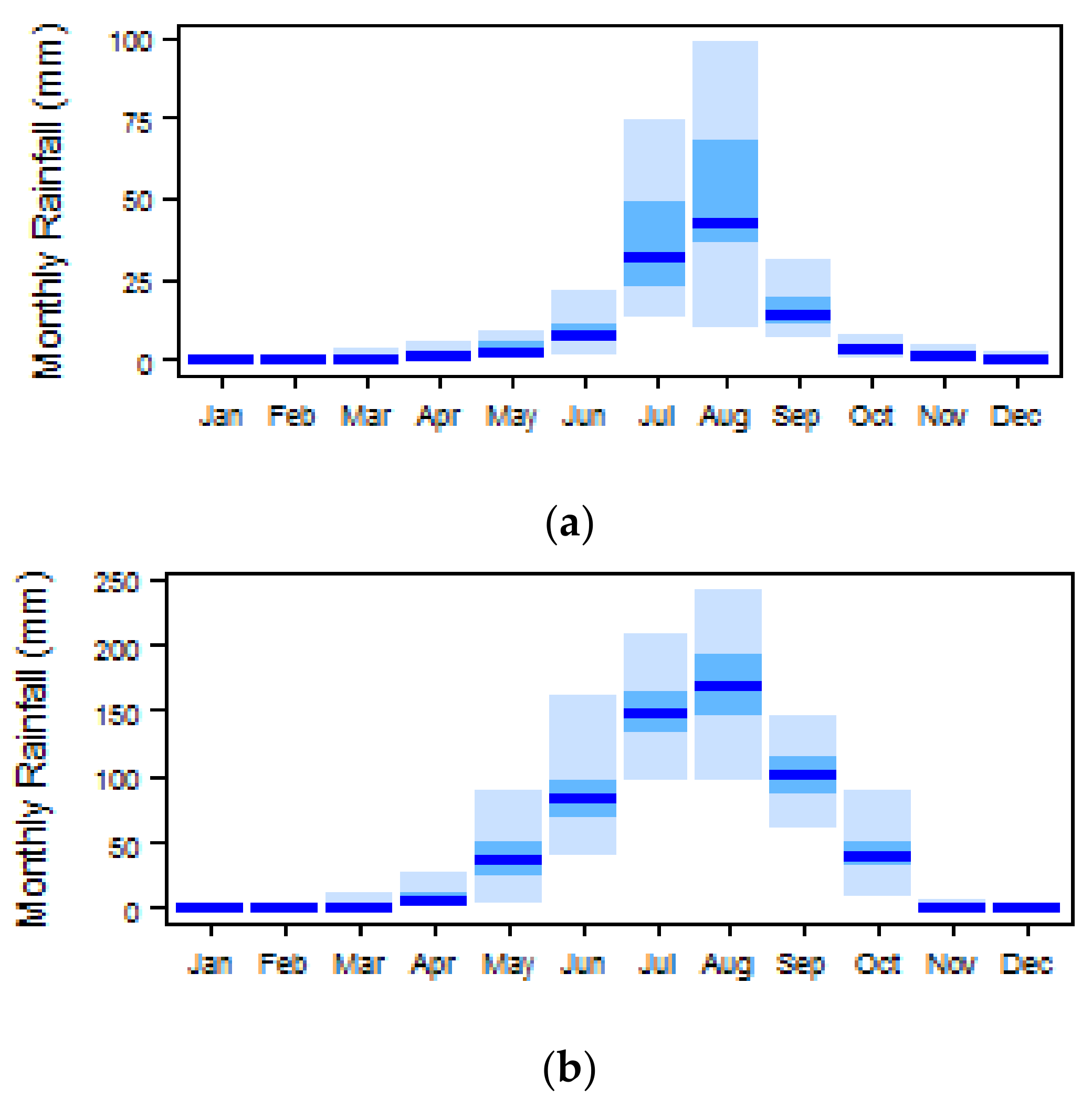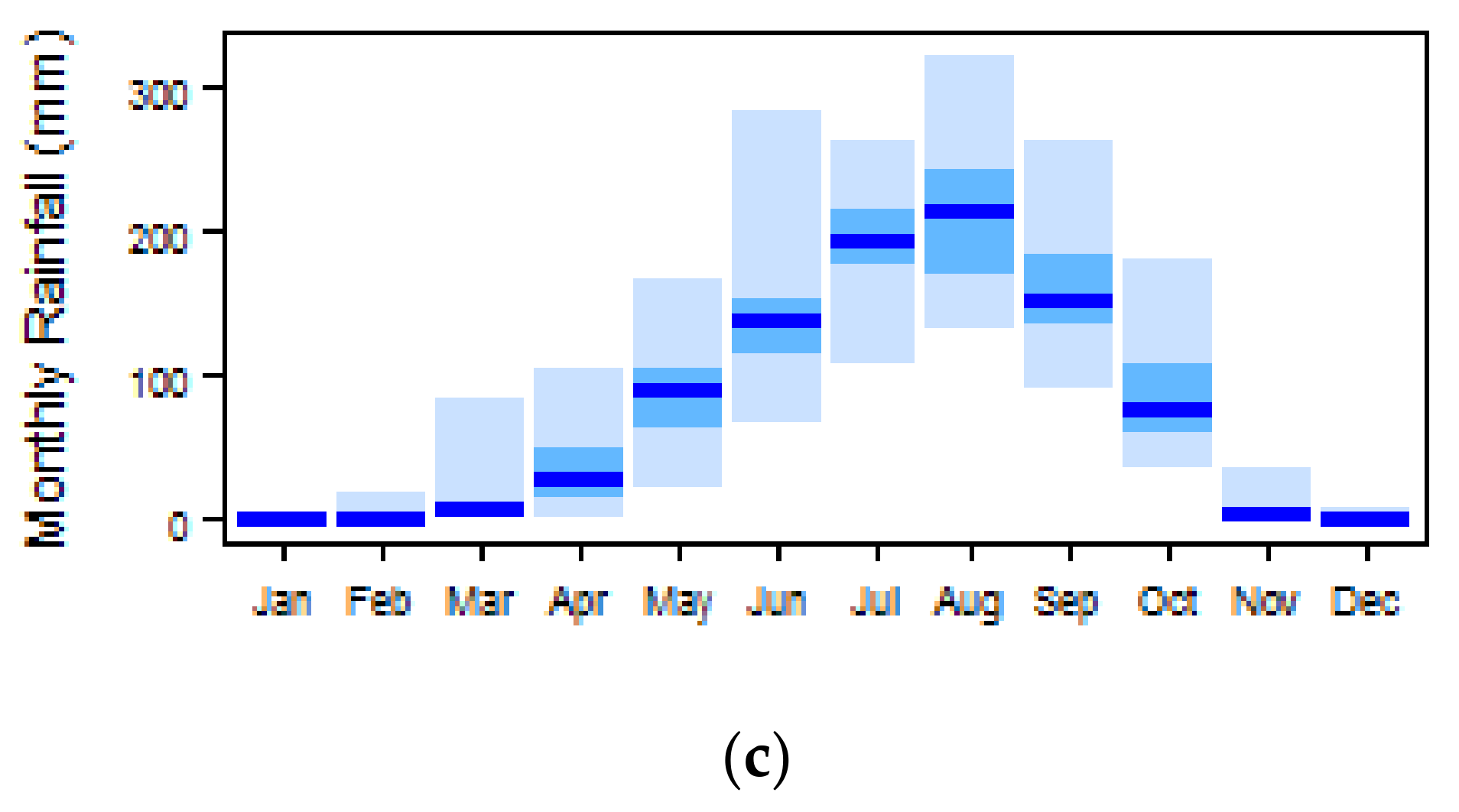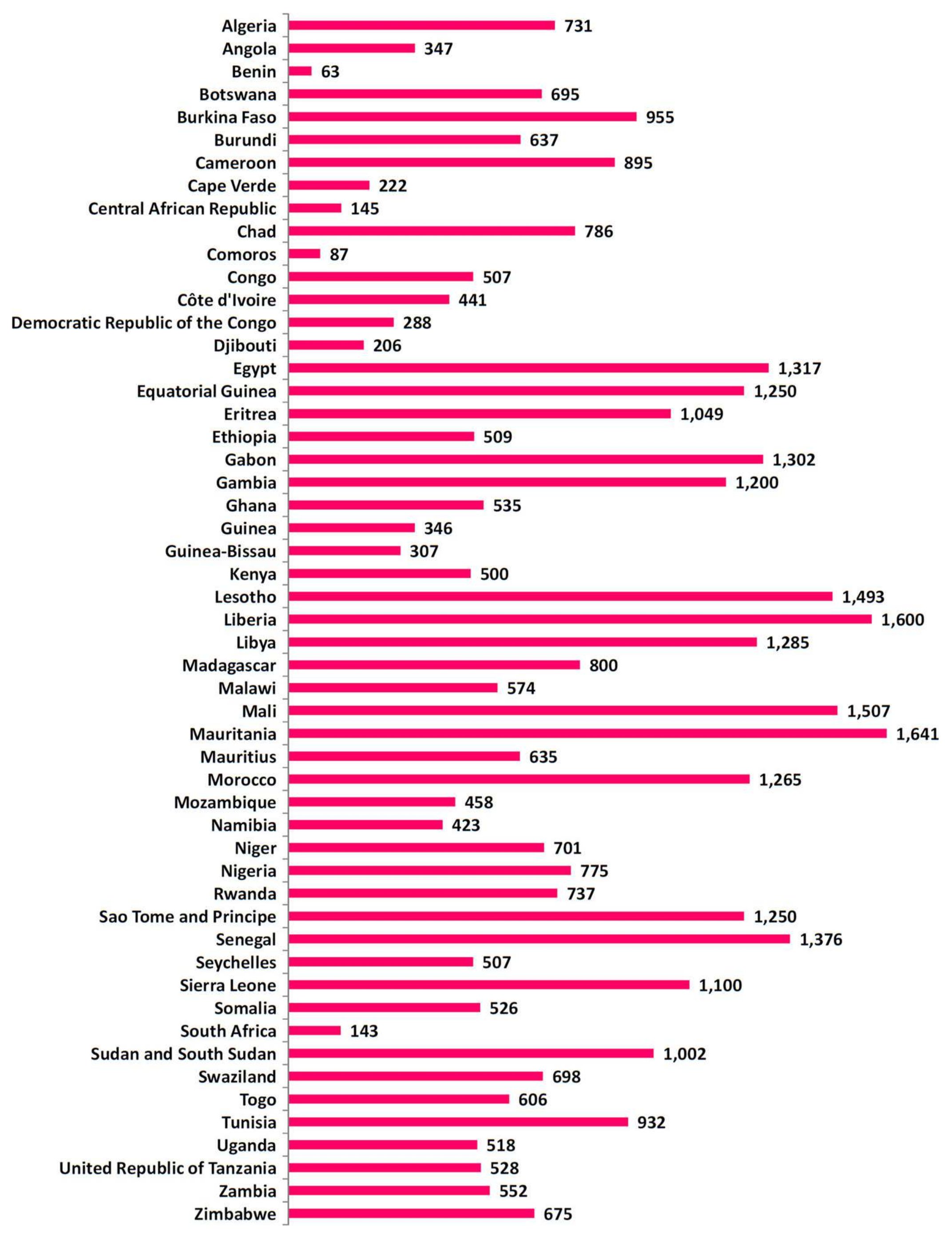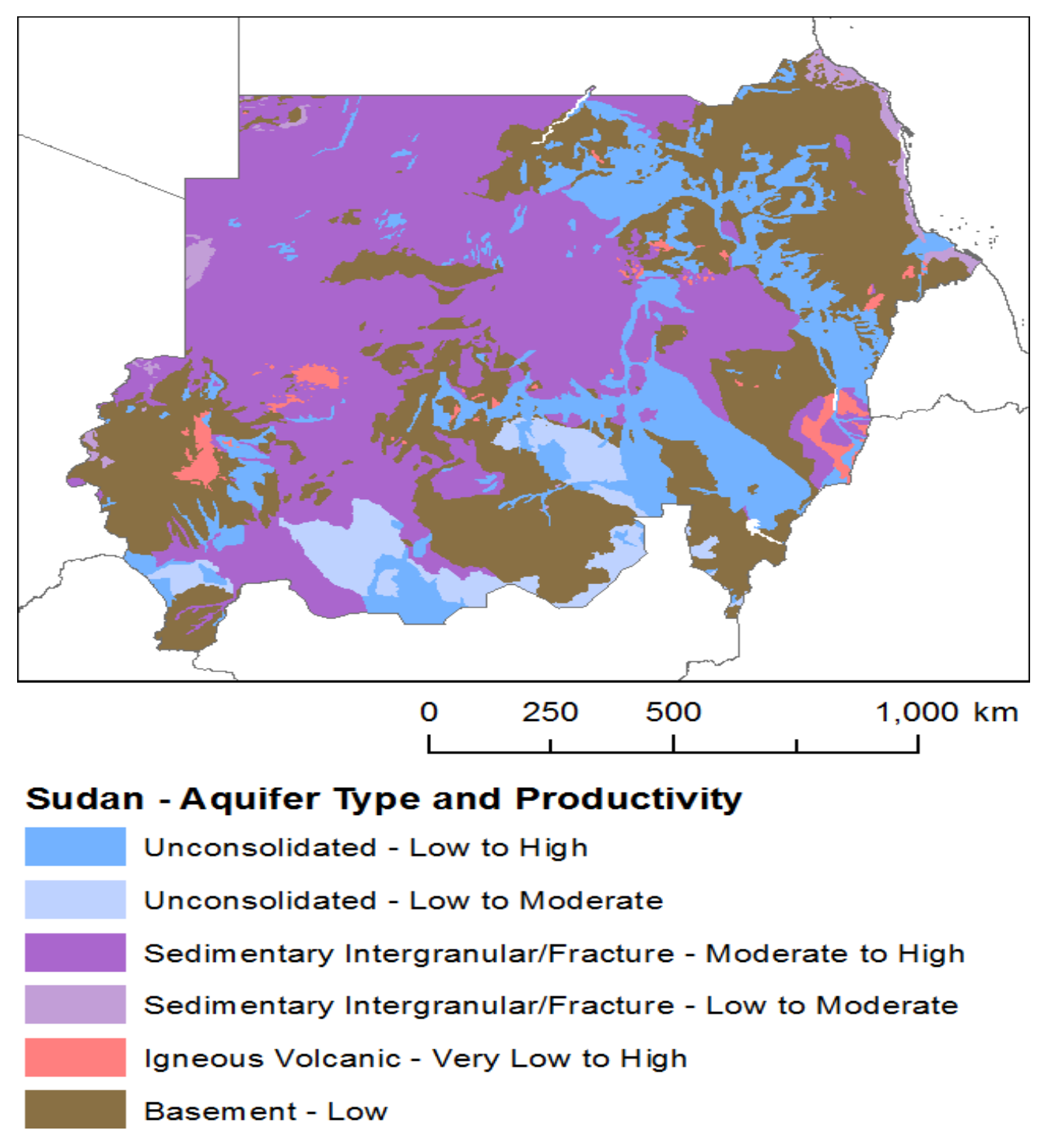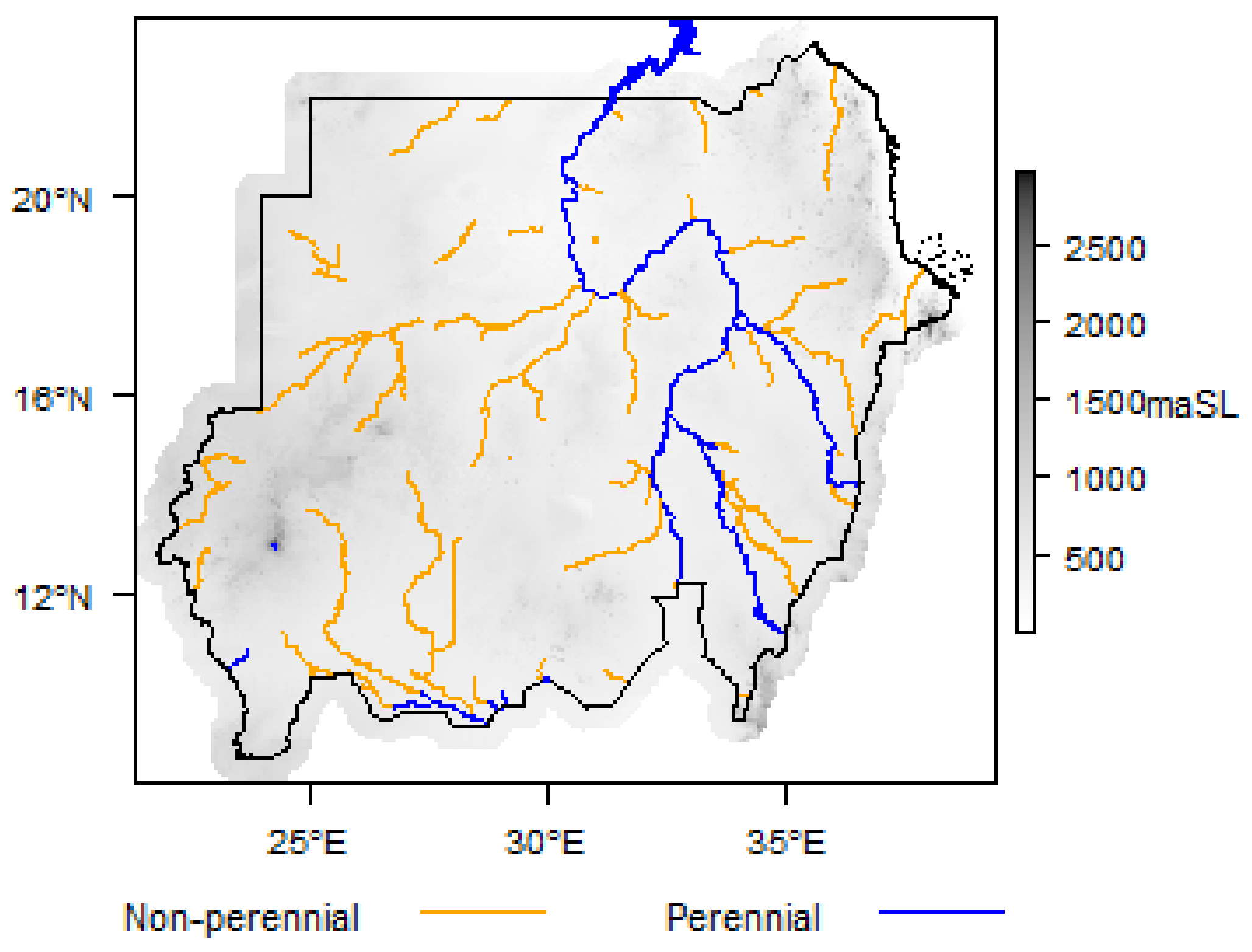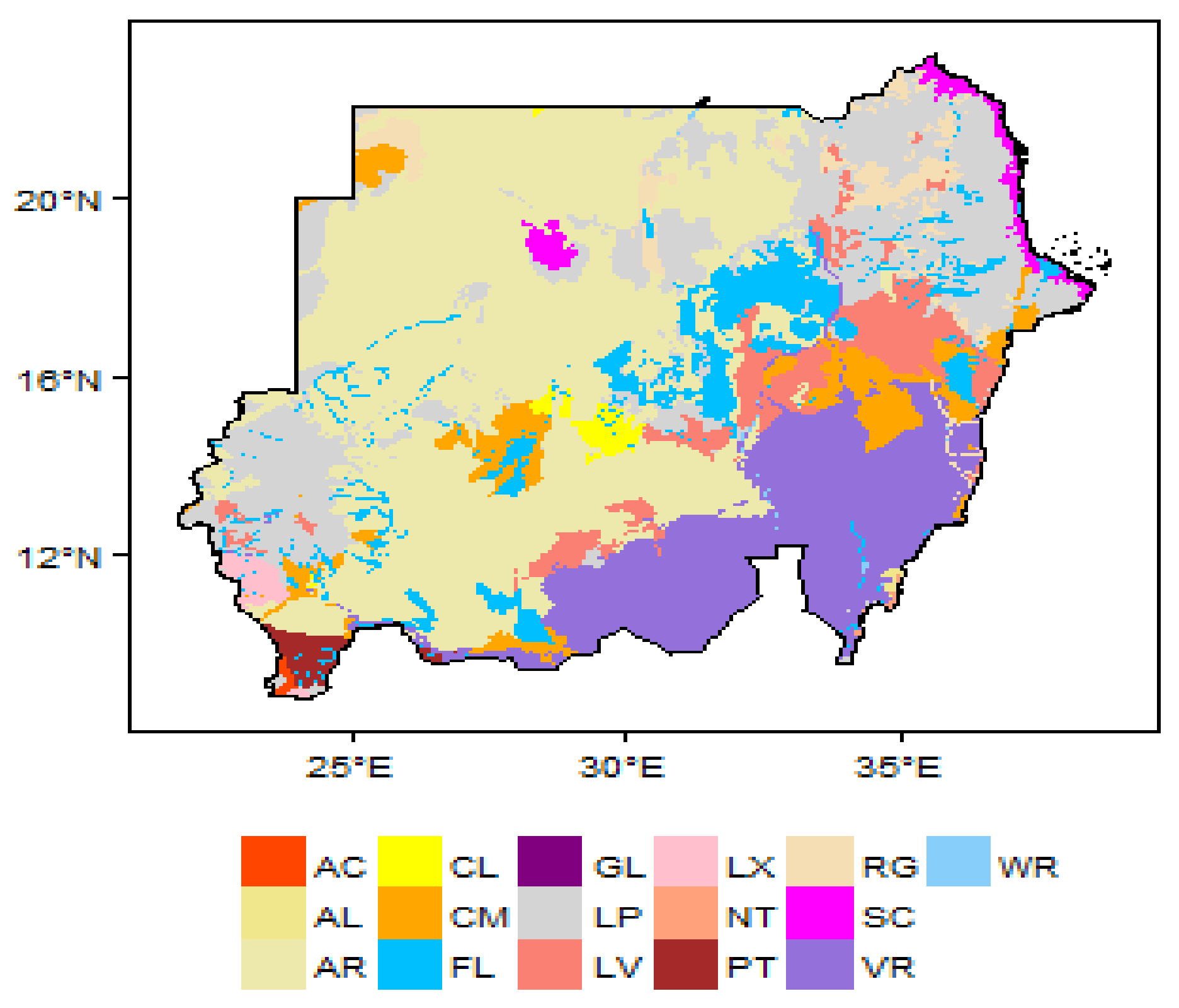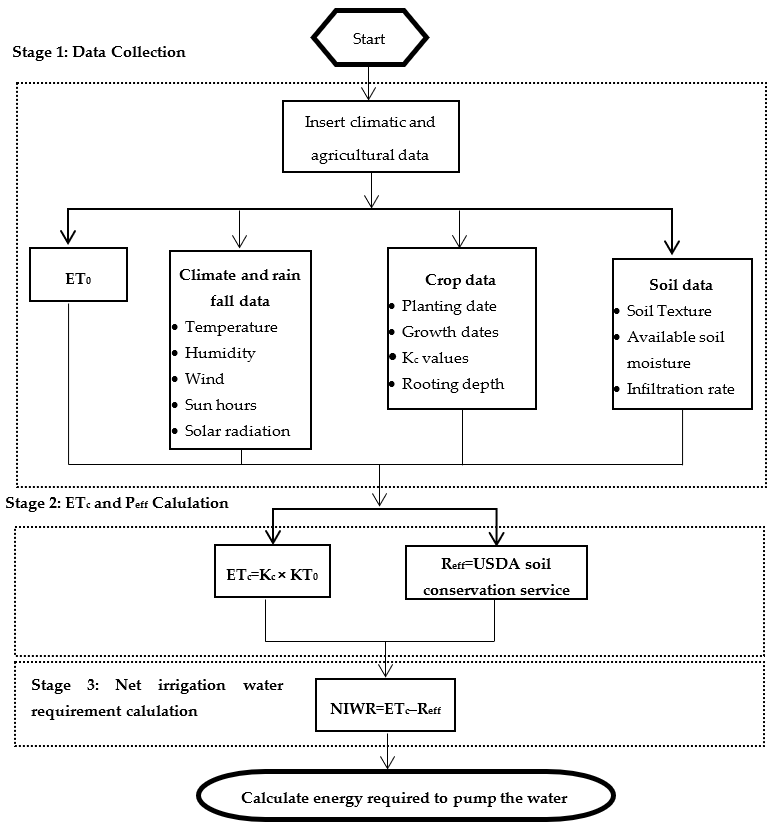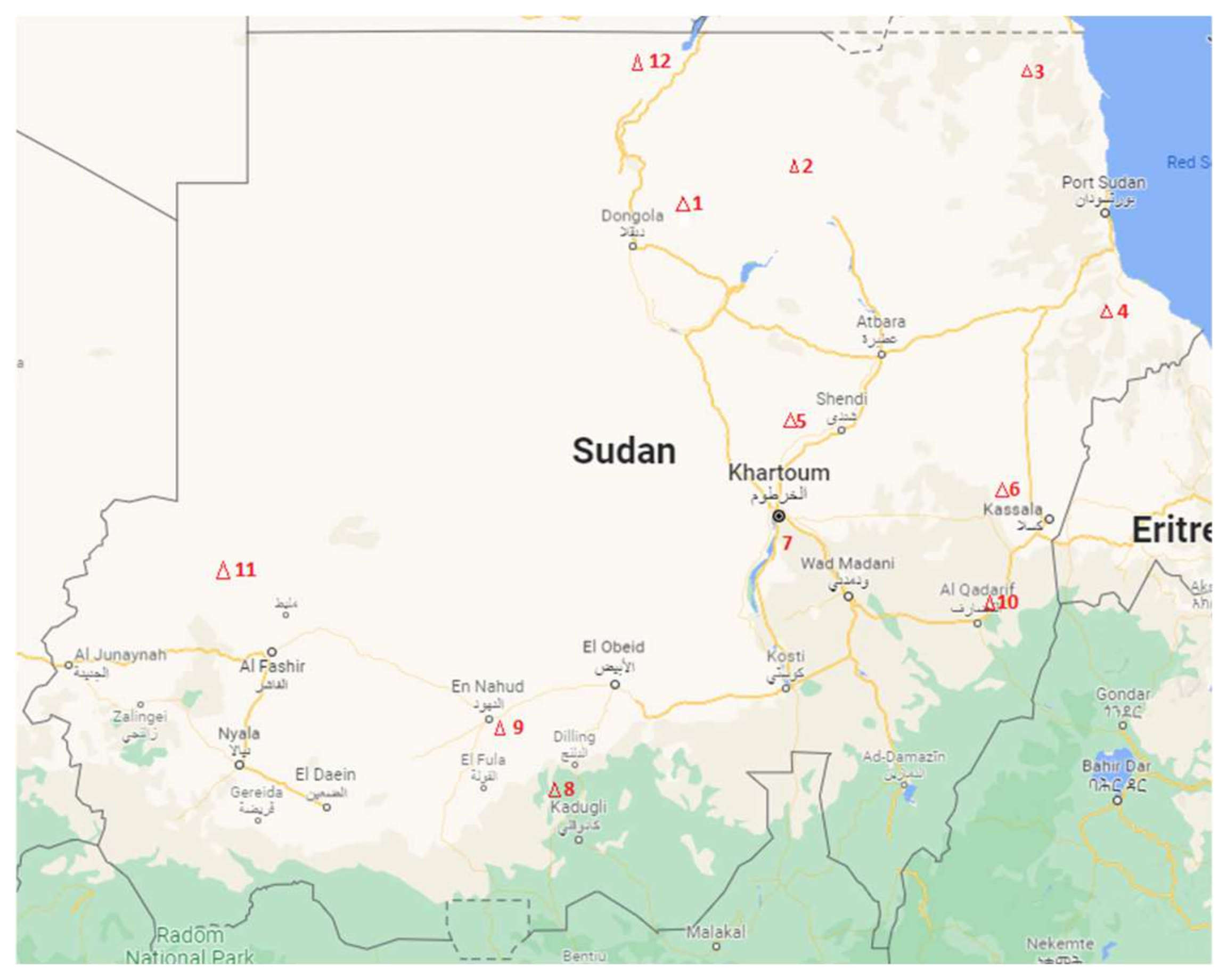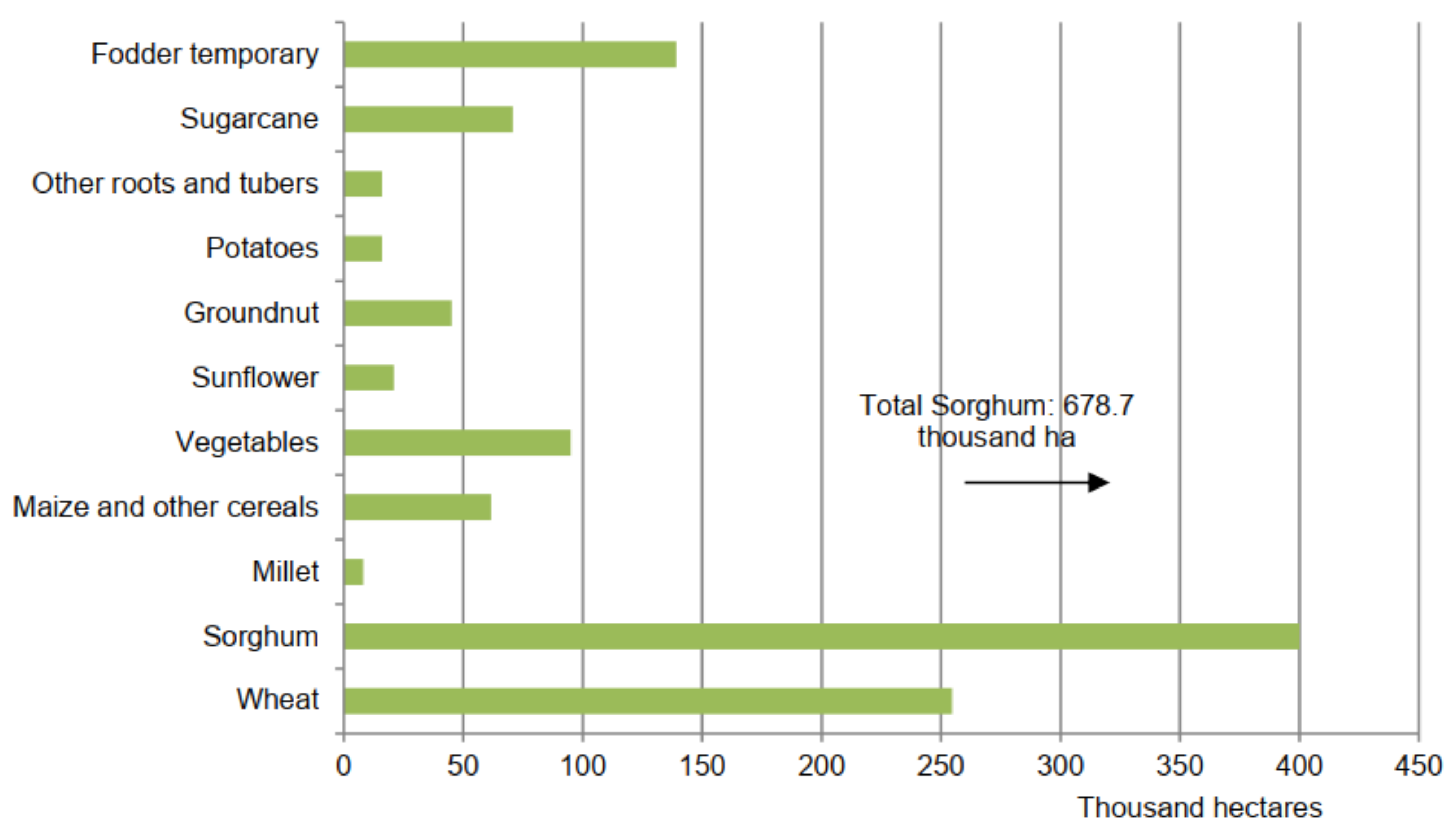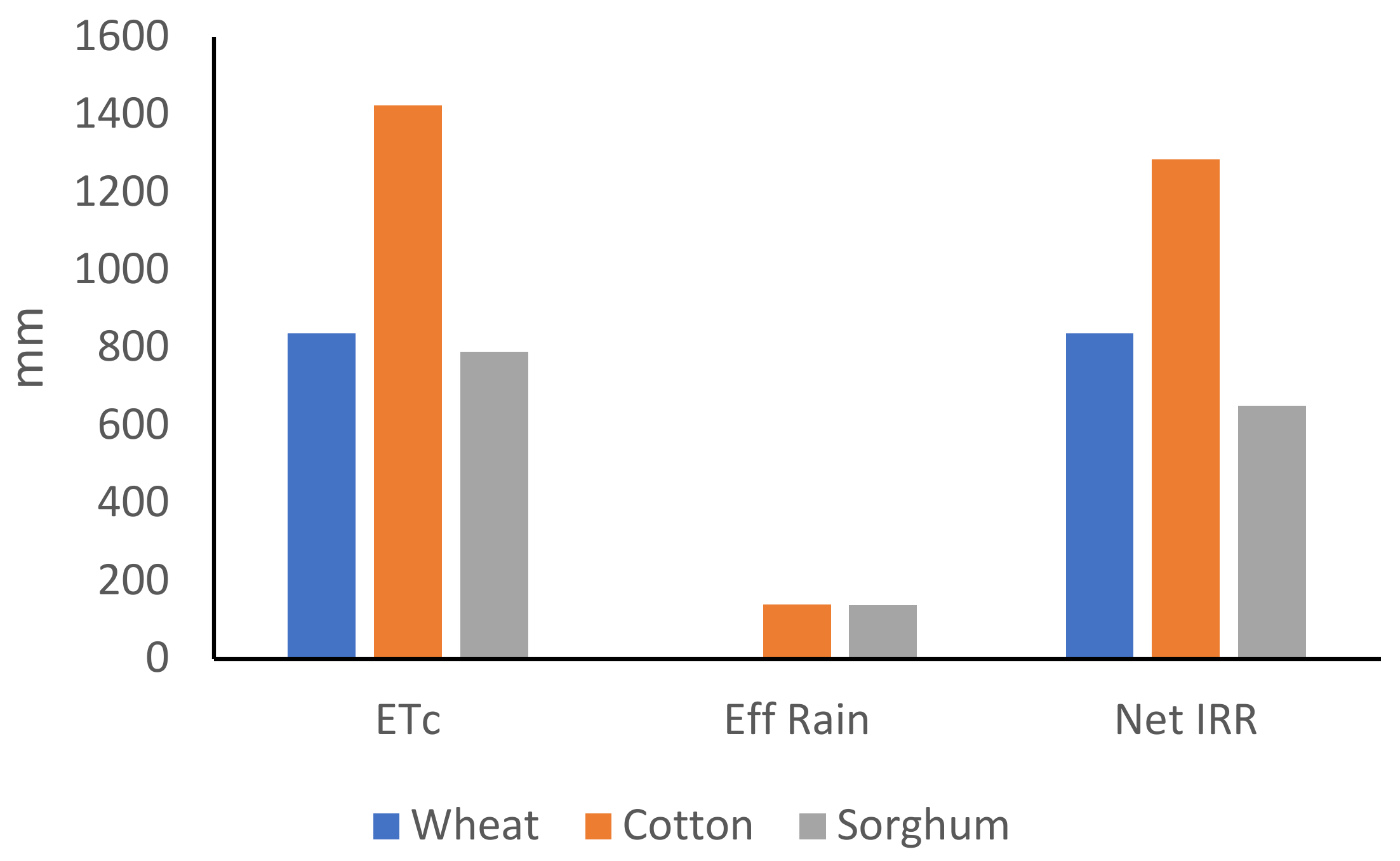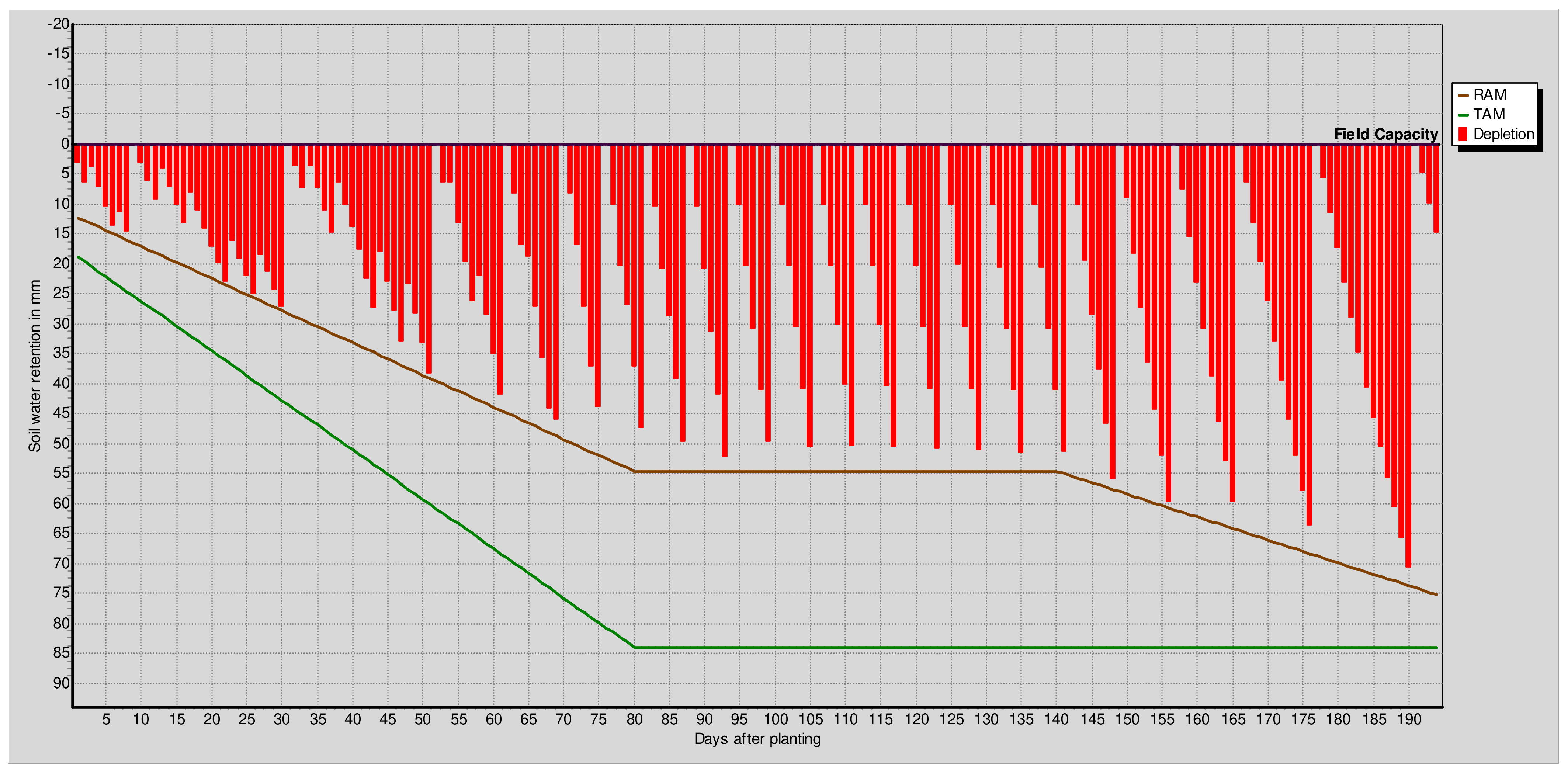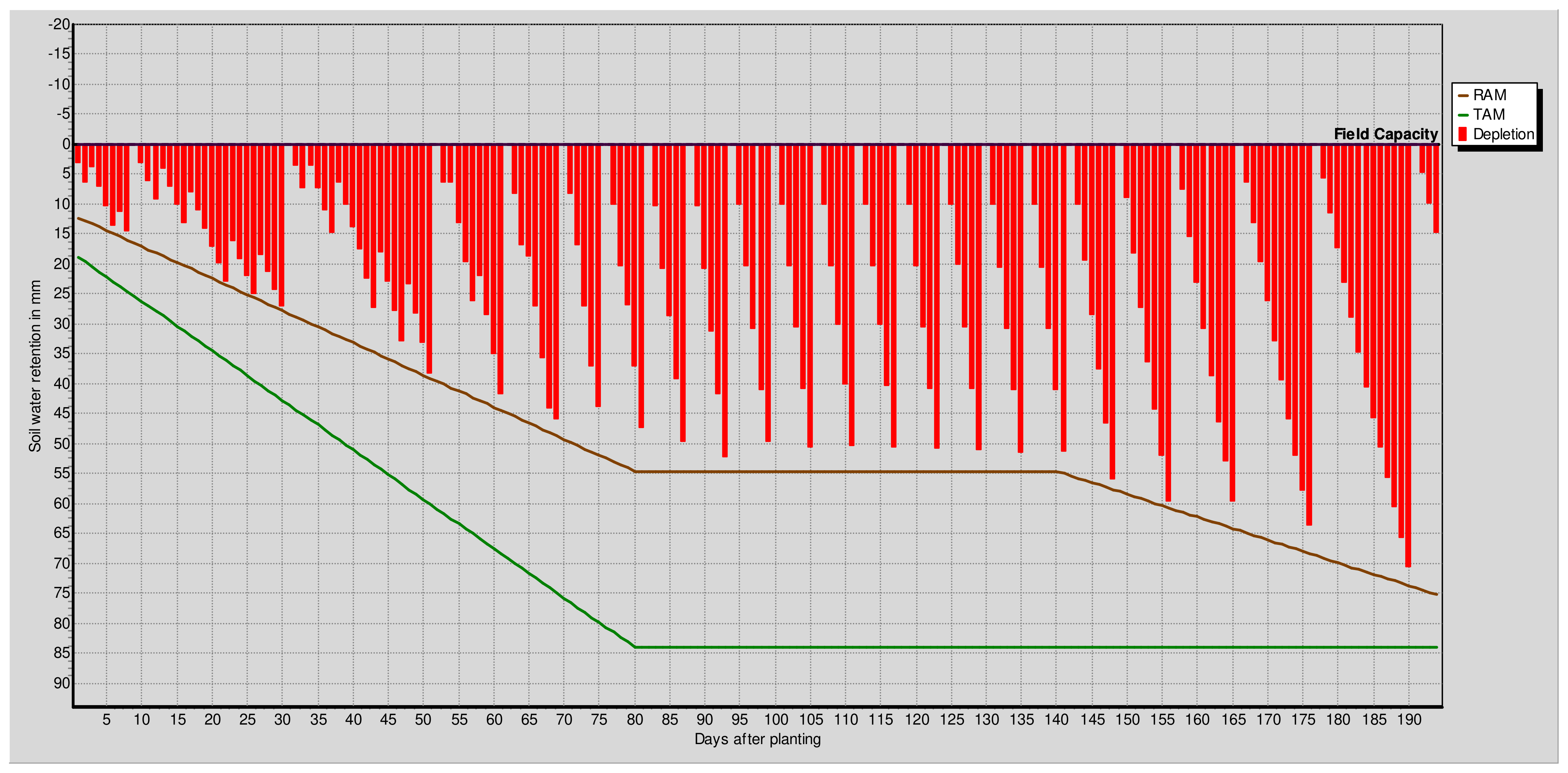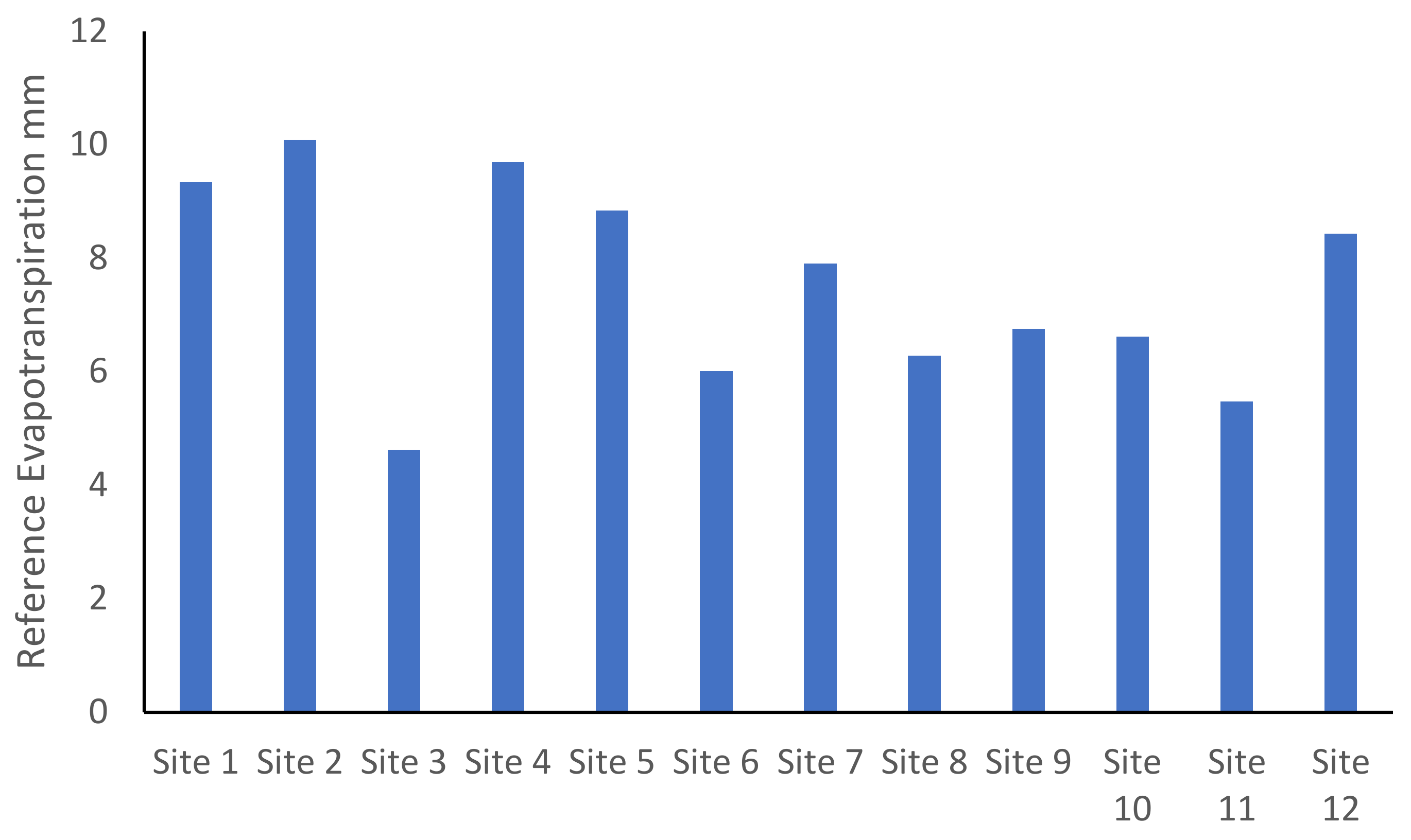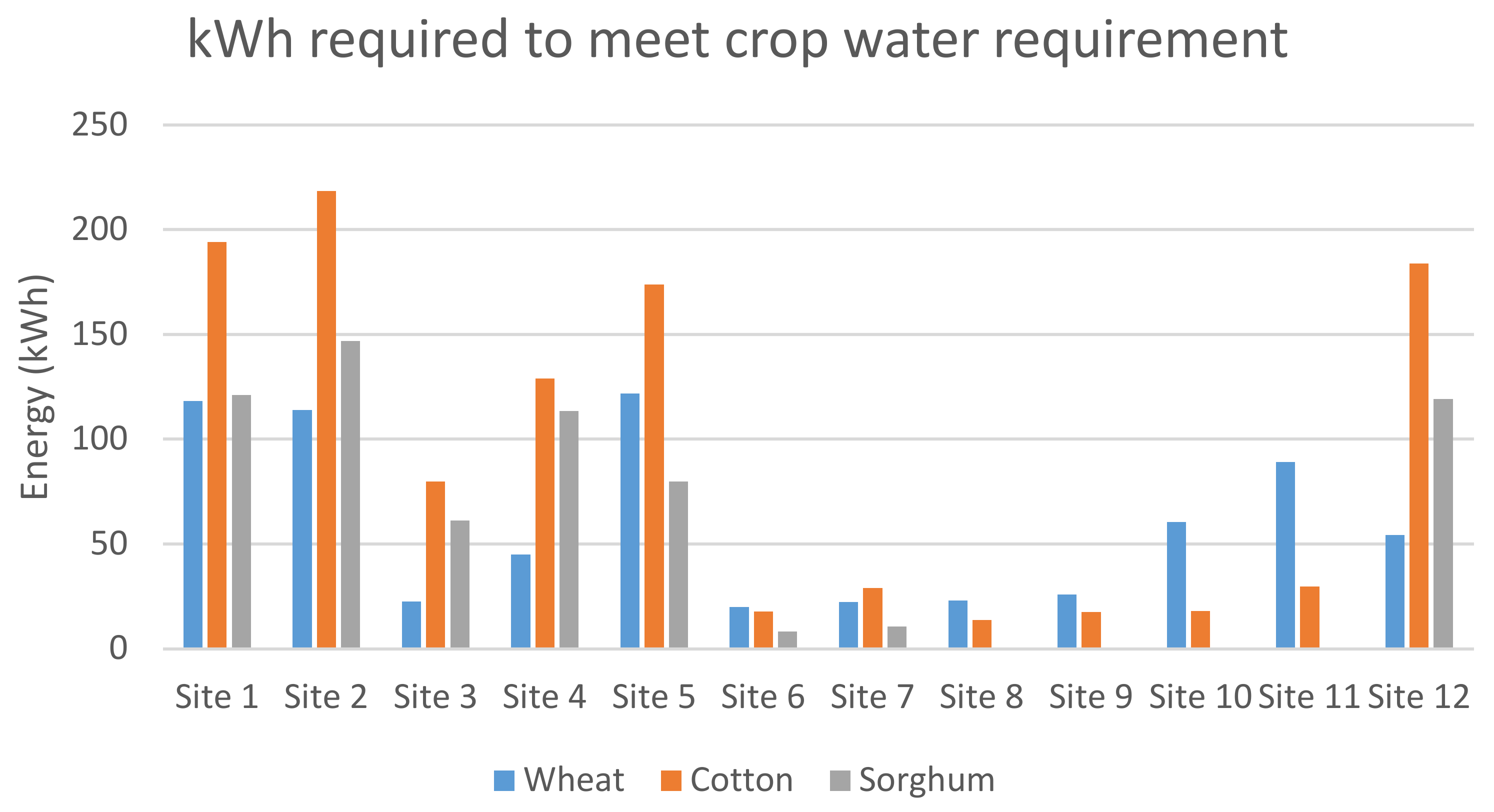1. Introduction
Agriculture is considered to be the backbone of Sudan’s economy, with an approximate contribution of up to one-third of the total GDP and with an estimated 39% of workers employed in the sector [
1]. Sudan was known as an Arab breadbasket in the 1970s, having high agricultural exports. However, a lack of resources and climate change exacerbated stresses for Sudanese people already struggling with poverty and environmental degradation, which impact those in rural areas more severely. The population of Sudan increased to 45 million in 2021, up from 31 million in 2008 [
1]. This increasing population requires more food, while the effects of climate change are imminent, involving changing weather patterns and droughts that increase uncertainty, resulting in a high risk to food security. Moreover, the use of fossil fuels to meet the energy demands exacerbates the impacts of climate change.
According to the Köppen–Geiger climate classification map of Sudan [
2], as can be seen in
Figure 1 and
Figure 2, most of the northern part of the country comes under the arid or desert climate classification (BWh), with very low rainfall that mainly occurs in July and August. The southern part has a semi-arid or semi-desert (BSh) climate, with maximum rainfall from June to September [
3,
4,
5]. A small southern portion of the country has a tropical savanna climate (Aw) and experiences frequent rainfall from May to October. The rainfall data were collected from the CRU TS 3.21 dataset, which contains monthly average rainfall rates from 1901 to 2012 [
4]. The lack of rain in large areas renders agriculture practices unproductive, since a large area of the country is totally dependent on rain.
Agriculture in countries with mostly arid climates tends to struggle. Moreover, global warming and climate change are also suppressing crop yields. Droughts are expected to continue to impose immense pressure on food security in fragile ecosystems [
6]. Global leaders have come together to reduce greenhouse gas emissions to control climate change, although the crops of today should be ready to endure new stresses, such as increasing droughts due to climate change, or these stresses should be managed via alternate options. To endure these stresses, the role of symbiotic microorganisms in plant phenotypic adjustments to environmental stresses has been explored in different studies [
7,
8,
9,
10]. According to the authors of [
11], fungal endophytes, an important constituent of the plant microbiome, may be key to the ability of plants to adapt to climatic stressors. Although these are interesting solutions that must be explored and adopted, immediate solutions to reduce the stressors are required to mitigate the water needs of crops.
Sudan contains 175 million feddans (73.5 million hectares) of suitable agriculture land, although only 26 million hectares is currently being sown [
1]. However, only 1 million hectares of the total arable land is irrigated, with 6.7 million hectares being managed using semi-mechanized rainfed agriculture methods and a whopping 9 million hectares being completely dependent on traditional rainfed agriculture methods. It is important to understand the climatic conditions in Sudan to fully understand the importance of irrigation for agriculture. However, in addition to Sudan, an overview of irrigation water requirements in Africa as whole shows that countries in Northern Africa tend to have higher crop water requirements, as shown by the in–out values for 53 countries (
Figure 3), with 15 countries having irrigation water requirement rates greater than 1000 mm. It is evident that these countries are in Northern Africa, with Sudan being one such country with high water demands. After the separation of South Sudan, Sudan’s reliance on agriculture increased, meaning the irrigation water requirements consequently increased.
Despite the fact that the irrigation water requirements in Sudan are very high, the country has a higher percentage of cropland equipped with irrigation as compared to most other African countries. This is clear in
Figure 4, showing that although the percentage of irrigation in Sudan is high, the country suffers from food insecurity.
The areas that are irrigated use the Nile River as the key source of water. Sudan has one of the largest irrigation schemes in the world, called the Jazirah scheme, which irrigates approximately 1 million hectares of the total 1.6 million hectares of irrigated land in Sudan [
14]. Some studies have pointed out the irrigation management challenges in the Gezira scheme [
15,
16]; however, better planning could always be utilized to improve the irrigation management [
17]. Apart from the river Nile, spate flows from seasonal rivers in the Gash and Tokar Deltas also contribute to irrigated agriculture [
1]. Irrigated agriculture also benefits from rain in summer, e.g., the Suki irrigation scheme sources 40% of its water from rain. However, from the hydrogeology map of Sudan [
18] presented in
Figure 5, it can be observed that the country has abundant resources of underground water [
18]. At the same time, from
Figure 6 it is clear that the Nile is the main perennial river, while the rest of the rivers are non-perennial.
Groundwater is the major source of water for locations away from the Nile basin and other non-Nelotic river wells. It is estimated that Sudan contains more than 900 billion cubic meters (BCM) of water reserves, with 1.563 BCM of annual recharge [
19,
20]. Despite having such an abundant amount of water to recharge aquifers, agriculture is still dependent on rain-fed conditions.
The utilization of the groundwater presents a multitude of challenges. The primary challenge in the utilization of groundwater is the lack of electricity in remote areas for water pumping [
15,
16]. Increasing fuel prices combined with increasing inflation make the utilization of diesel generators costly, hazardous for the environment, and financially unsustainable. Recent developments in renewable energy systems have increase their potential for utilization in irrigation. However, the costs of renewable energy sources such as solar photovoltaic (PV) systems are considered to be high due to the high initial capital costs [
21,
22]. Although there are many financing opportunities being provided by Sudan’s government and international organizations such as the United Nations Development Program (UNDP) to promote renewable energy for sustainable agriculture, the accurate determination of water requirements dictates the cost and viability of renewable energy options. This cost is often overestimated due to a lack of knowledge regarding the crop water requirements. Oversizing incurs extra costs, while undersizing can lead to insufficient performance. This is why there is a need for scientific studies that consider irrigation holistically starting from the crop water requirements to determine the amount of energy required and to size the water pumping system.
Some studies have made efforts to determine the crop water requirements, e.g., Schumacher et al. [
23] studied the water requirements for urban agriculture in Khartoum. Similarly, Elhag and Ahmed [
14] analyzed the irrigation water requirements for the Gezira scheme, while Jabow et al. [
24] explored the crop water requirements for tomato, common bean, and chickpea crops in Hudeiba, Sudan. However, a study that considers crop water requirements for different areas in Sudan is urgently required to enable meaningful water planning and the development of cost-effective sustainable irrigation systems across Sudan to alleviate food insecurity. This study seeks to fill this gap by establishing crop water requirements for important crops in Sudan, namely wheat, cotton, and sorghum crops. This will not only improve the knowledge regarding crop water requirements and help in determining the resources required but will also improve the planning process and water management for irrigation. Moreover, the limitation of the data required to calculate the average size of the water pumps is addressed by exploring crop water requirements for different areas and by calculating the amounts of energy required at all sites for each crop. The rest of the paper is organized as below.
Section 2 present the methodology adopted to calculate the crop water requirements and pump size.
Section 3 delineates the case studies considered in this paper. The results of the case studies are presented in
Section 4.
Section 5 concludes the paper.
2. Methodology
Sudan is divided into 18 states for administrative purposes, as can be seen in
Figure 7 [
25]. However, as the aim of this study is to compare crop water requirements for different crops in different regions, two factors are considered herein for site selection. Firstly, the classification of Sudan according to climatic conditions (
Figure 1) is considered as the crop water requirements are highly dependent on climate. Lastly, crop water requirements depend on the type of soil; thus, the soil map of Sudan given in
Figure 8 is used to determine the soil types at selected sites for which soil data were not available. Thus, the selected areas are based on the different climatic conditions and dominant soil types.
Once the study sites are selected, the process for the calculation of the crop water requirements is initiated. Here, the crop water requirements are assessed using CROPWAT software, which is a decision support system developed by the FAO of UN [
15]. It considers a number of inputs, such as the crop type, soil type, and climatic data to calculate reference evapotranspiration (ET
0), crop evapotranspiration (ET
c), net irrigation water requirement (NIWR), and gross irrigation water requirement (GIWR) values. To calculate the crop water requirements, the methodology presented in
Figure 9 is adopted herein.
The calculation of the crop water requirements can be divided into three distinctive stages, i.e., data acquisition, computation of the ET
c, and computation of the effective rainfall. Soil data were obtained from the FAO database, which classifies soil types into different categories. The literature was used to correctly classify the soils at the selected sites [
26]. The climatic data from the FAO [
15] for long-term monthly averages for 15 years covering different periods from 1971 to 2000 are available in the CLIMWAT 2 module, which can be directly used in CROPWAT [
15]. Although the dataset from CLIMWAT contains averaged data for a long period collected from over 5000 weather stations globally, considering the ongoing climate changes and carbon emissions, this dataset needs to be updated. However, due to a lack of data, the existing CLIMWAT dataset will be used. Apart from the rainfall and temperature data, the most important value is evapotranspiration. Transpiration and evaporation occur at the same time, and when combined with each other are often referred to as evapotranspiration (ET). The rate of ET from a hypothetical crop is called the reference evapotranspiration (ET
0). The rate of ET from a hypothetical crop with a height of 0.12 m, albedo of 0.23, and fixed canopy resistance of 70 sm
−1 is called the reference evapotranspiration [
27].
The FAO CROPWAT model uses the FAO Penman–Monteith equation for the calculation of ET
0 based on weather data [
28]. The net irrigation water requirement is calculated using the crop evapotranspiration (ET
c) and effective rainfall (R
eff) values. The ET
c is calculated using (1) [
27]:
where K
c is the crop coefficient. K
c represents an integration of the effects of four essential qualities that differentiate the crops from the reference grass, which covers the albedo (reflectance) of the crop–soil surface, crop height, canopy resistance, and evaporation from the soil [
29]. K
c varies with the crop development and is divided into four different stages, i.e., initial, development, mid-season, and late-season stages.
The crop water requirement is defined as the amount of water needed to maintain the moisture level by identifying the water lost through evapotranspiration (ET
c) for a disease-free crop. Therefore, the crop water requirement essentially represents the ET
c values obtained over different seasons. However, when calculating the irrigation requirements, other sources of water also need to be considered. If there is no rainfall, the ET
c is considered to be the water required for the crop, whereas for rain or deep seepage, the net irrigation water requirement (NIWR) will be lower, as given in (2) [
27]:
Once the crop water requirement is calculated, the total energy requirement to meet the crop water requirement is calculated. To calculate the power requirement, the total water discharge calculated using CROPWAT is used as in (3) [
30]:
where
Q is the flow of water (m
3/s),
is the density of water (kg/m
3),
g is the acceleration due to gravity (m/s
2), and
H is the differential head (m). Using (3), the power required to lift water is calculated in kW, which can be converted into daily energy.
4. Results and Discussions
Once all data were available, the crop water requirement was calculated, i.e., ET
c. Irrigation management can be improved with precise knowledge of the irrigation water requirements for the crop and irrigation time. Controlling the amount, timing, and rate of irrigation in an efficient and planned manner is the key to successful irrigation management. Therefore, it is imperative to calculate the water requirement and the irrigation schedule. It is important to note that the K
c values of each crop varied with the development stage. Depending on the K
c value, the crop water requirement will vary. The water requirements for all 3 crops at site 5 (Khartoum) are presented in
Table 4,
Table 5 and
Table 6.
Table 4,
Table 5 and
Table 6 show that the cotton crop requires more water than wheat and sorghum. The selected site experiences little rain and the overall impact of the rain is not significant during the examined months. This highlights the need for a robust irrigation system for crops in the area to improve the yield and ensure high productivity.
Figure 12 shows a comparison of ET
c, effective rain, and net irrigation requirement values for site 5 for 3 different crops during their lifetimes. This shows the lack of rain and higher water requirements for cotton and sorghum.
Further to the knowledge of irrigation requirements, the irrigation schedule plays an important role in the crop yield. The crop yield can be increased with appropriate irrigation at the appropriate time.
Table 7,
Table 8 and
Table 9 provide detailed irrigation water requirement data, including the net irrigation, gross irrigation, and flow rates required. The schedule is given in
Figure 13,
Figure 14 and
Figure 15. The figures show that wheat requires 21 irrigation cycles with a total of 837 mm of water, cotton requires 22 irrigation cycles with 1283 mm of water, and sorghum requires 14 irrigation cycles with 650.8 mm of water.
Figure 16 presents irrigation water requirements for the three crops at all 12 sites.
Figure 16 shows that in all cases cotton requires the highest level of water, although the differences between the irrigation water rates for wheat and cotton vary significantly according to site. This is due to a multitude of factors, particularly the effective rain rate, crop characteristics, and soil characteristics. These factors play vital roles, although the ability of soil to retain moisture and effective rain plays a significant role in this variation. It is interesting that the areas in the northern region require significantly higher levels of water, except for site 3. Site 3 is located close to the red sea and the climatic conditions are comparatively less harsh. Site 4, which is also located near the red sea, tends to require a higher amount of water due to higher temperatures. This points out the importance of temperature, which plays a vital role in evapotranspiration. A comparison with the reference evapotranspiration rate is shown in
Figure 17, which reveals that the northern regions have higher evapotranspiration as compared to the southern regions.
The comparison of the number of irrigation cycles required at different sites with different soil types presents interesting results. With more sandy soil types, the number of irrigation cycles tends to be higher, whereas soil types with higher amounts of clay tend to require lower numbers of irrigation cycles. This can be observed from
Figure 18, where the southern sites tend to require lower numbers of irrigation cycles (as low as 2). It is interesting to note that although site 3 has the lowest irrigation water requirement, this does not necessarily mean the number of irrigation cycles will be the lowest. Therefore, a comprehensive understanding based on scientific studies such as this is essential for successful irrigation management.
The higher crop water requirements and numbers of irrigation cycles tend to mean that higher amounts of energy will be required to pump the water and more frequent operation of the pump will be required. The crop water requirement data for all 12 sites were used to calculate the amount of energy required by each crop at each site and are given in
Figure 19. It was assumed that the water will need to be lifted to a height of 40 m, with a pump efficiency rate of 80%.
This study has analyzed a number of different sites in terms of the water required for different crops and calculated the amount of energy required to pump this water. The results can be used as a benchmark to compare per hectare crop water requirements in different areas of Sudan and the energy required to aid in the design of the pump size. Overall, arid areas tend to have higher water requirements for the same crop as compared to semi-arid areas. However, variations in crop water requirements in different regions for different crops were observed due to rain patterns. Cotton, being a crop that requires high amount of water, did not require more water at sites 6 to 11. This was mainly due to the weather and rain patterns. Sorghum is a weather-tolerant crop, although at some sites it required higher amounts of water as compared to wheat. These data are important to determine the impacts of climate change and particularly to develop resilient crops that are resistant to stresses resulting from climate change and other factors.
The crop water requirement results were used to calculate the electricity needed (kWh) by water pumps in different areas. The energy requirements at different sites show that the sites located further north tend to have higher energy demands and are potential candidates for renewable energy development. Higher energy demands warrant the use of hybrid energy, which can be beneficial in agricultural applications, helping to reduce energy poverty and improve yields, and consequently helping to reduce poverty and improve food security. Some studies have developed renewable energy systems for irrigation purposes, although these studies did not adopt the detailed approach of determining the energy demands according to the crop water requirements [
34,
35]. A systematic approach to determining the energy demands of crops has been presented herein. The results from this study will be used as a stepping stone to develop feasible renewable energy system options for the different sites in Sudan. This study will pave the way for the integration of future renewable energy sources into the agricultural sector, which will help in reducing pollution by cutting carbon emissions and increasing savings for farmers by reducing their expenses for fuels.
5. Conclusions
This study has presented a comparison of crop water requirements for three different crops at 12 different sites in Sudan. Moreover, the amounts of energy required for all sites to meet the water requirement have been calculated. The comparison suggested that the areas that are arid and located in the north require higher amounts of water and have less effective rainfall. However, the significance of temperature is higher for the sites located near the red sea. The results suggest that depending on the climatic conditions, the crops requiring high amounts of water in arid regions might not necessarily be the ones requiring the highest amounts of energy. The depth of the borehole and other climatic conditions play bigger roles in the energy requirements. The data for crop water requirements have been translated into energy requirements according to the different borehole depths at each site. The northern regions tend to require higher amounts of energy to meet the crop water requirements but at the same time they tend to have longer daylight hours and higher winds, making them suitable candidates for hybrid energy generation.
Thus, the use of tools such as CLIMWAT and CROPWAT can be beneficial in planning and managing irrigation systems with a significant degree of confidence. The use of these tools will not only be beneficial by providing information regarding the crop water requirements but will also provide information about when and how much water is needed for the optimum development of the crops. These tools can be beneficial not only in terms of increasing crop yields but also in planning the use of resources, such as the energy required to supply the water required for crops. Future studies will include the development of hybrid renewable energy systems for the different areas in Sudan using the energy requirements calculated in this study. Specifically, the use of hybrid renewable energy (e.g., solar PV and wind) is particularly advantageous because there are no operational GHG emissions, which have been mainly attributed to climate change and have produced unprecedented consequences in recent time. Additionally, the costs of renewable energy conversion technologies have decreased rapidly in recent years. Other future studies will include an exploration of the techno-economic feasibility of different renewable energy systems to meet energy demands and crop water requirements for the sites and crops presented in this study.

